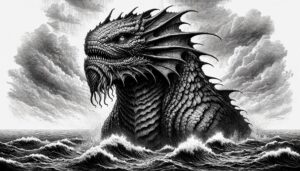Table of Contents
An Aswang is a mythical creature in Filipino folklore, often depicted as a shape-shifting monster or vampire-like being associated with night and dark magic.
Who is Aswang?
The Aswang, a carnivorous shapeshifter, masquerades as an ordinary townsfolk by day, often noted for reclusive habits or mystical skills. Come nightfall, it transforms into a haunting predator, seeking human prey, with a preference for feasting on children and pregnant women.
Aswang: Characteristics
Shape-shifting: Aswangs are believed to have the ability to transform their physical appearance, often taking the form of a human or an animal. This shape-shifting ability allows them to move about undetected in society.
Human Appearance: In their human form, aswangs are often described as ordinary-looking individuals. They can blend into the community and may even have families or social interactions.
Monstrous Form: In their monstrous form, aswangs are said to have distinct physical features that reveal their true nature. These features may include sharp teeth, long tongue, red eyes, and sometimes wings. The appearance can vary, and different regions have their own specific details.
Hunger for Human Flesh: One of the most well-known characteristics of the aswang is its supposed appetite for human flesh. It is said to feed on unborn fetuses, particularly targeting pregnant women, or on small children. Some variations of the aswang legend suggest they consume the internal organs or blood of their victims.
Night Dweller: Aswangs are often associated with the night and are said to be more active during darkness. They are believed to have heightened senses that help them locate their prey.
Ability to Fly: Some regional variations of the aswang legend include the ability to fly, allowing them to move swiftly and covertly.
Avoidance of Garlic and Salt: Similar to Western vampire lore, aswangs are said to avoid garlic and salt. These items are believed to repel them.
Detachable Lower Torso: In some versions of the aswang myth, particularly in Visayan folklore, it is said that the creature can detach its lower torso and fly around to search for victims while leaving the upper torso behind.
Beliefs in the aswang vary widely across different regions in the Philippines, and the characteristics and behaviors associated with the creature can differ accordingly. The aswang myth is deeply rooted in Filipino culture and has been passed down through generations as a way to explain certain mysterious occurrences.
Special Abilities
The aswang is often attributed with various supernatural abilities in Filipino folklore. While the specific abilities can vary between different regions and versions of the myth, some commonly ascribed special abilities:
Shape-shifting: As mentioned earlier, the ability to change forms is a central characteristic of the aswang. This allows them to disguise themselves as ordinary humans or animals, making it easier for them to move undetected.
Flight: In some variations, aswangs are believed to have the ability to fly, either with wings or through some magical means. This enhances their mobility and allows them to reach their prey more easily.
Superior Senses: Aswangs are often described as having heightened senses, particularly at night. This includes enhanced hearing, sight, and smell, making it easier for them to locate their victims in the dark.
Teleportation: Some versions of the aswang myth suggest that these creatures can teleport or move rapidly from one place to another, further aiding in their ability to elude capture.
Invisibility: In certain tales, aswangs are said to possess the power of invisibility, allowing them to move about without being seen by humans.
Mind Control: There are stories that suggest aswangs have the ability to control the minds of their victims or manipulate their perceptions, making it easier for them to approach unnoticed.
Regeneration: In some versions, the aswang is said to have regenerative powers, allowing it to heal quickly from injuries. This adds to the creature’s elusiveness and makes it challenging to defeat.
Hypnotic Gaze: Some accounts describe the aswang as having a hypnotic gaze that can mesmerize or paralyze its prey, rendering them helpless.
These abilities can vary widely depending on the specific regional folklore and the storyteller. The aswang myth is a rich and diverse part of Filipino folklore, with different communities having their own unique interpretations of the creature and its powers.
Weaknesses
Garlic and Salt: Similar to vampire lore in other cultures, garlic and salt are often considered to repel aswangs. It is believed that these substances create a barrier that the creature cannot cross.
Holy Objects: Aswangs are said to be repelled by religious symbols and objects, such as crosses, holy water, and prayers. Displaying or using these items is thought to protect individuals from the aswang’s harm.
Sunlight: In some versions of the myth, aswangs are believed to be vulnerable to sunlight. Exposure to sunlight is said to weaken or destroy them. This weakness ties in with the notion that aswangs are creatures of the night.
Silver: In certain Filipino folklore, aswangs are said to be vulnerable to silver. It is believed that silver weapons or objects have the power to harm or kill them.
Blessed Items: Items that have been blessed by a religious figure, such as a priest, are thought to have protective properties against aswangs. This can include blessed oils, talismans, or other sacred items.
Prayers and Rituals: Reciting prayers or performing specific rituals, particularly those associated with spiritual cleansing or protection, are believed to ward off aswangs.
Community Vigilance: In many stories, the community plays a crucial role in protecting itself from aswang attacks. Vigilance, cooperation, and a sense of community are considered important defenses against these mythical creatures.
These weaknesses and protective measures are part of the folklore and are not applicable in the real world. The aswang myth serves as a cultural narrative with moral and social implications, often emphasizing the importance of community, morality, and religious faith in overcoming adversity.
Related Creatures
In Filipino folklore, there are several other mythical creatures that share the stage with the aswang. These creatures often have distinct characteristics and play different roles in local myths and legends. Few related creatures:
Manananggal: The manananggal is often mentioned in the same breath as the aswang and is sometimes considered a specific type of aswang. It is known for its ability to separate its upper torso from the lower part of its body, which it leaves behind while it flies around in search of victims. The manananggal is typically associated with attacking pregnant women and sucking the blood of fetuses.
Tikbalang: The tikbalang is a creature with the lower body of a horse and the upper body of a human. It is known for being mischievous and is said to lead travelers astray, especially at night. Appeasing or tricking the tikbalang is often advised to avoid its pranks.
Kapre: The kapre is a giant, tree-dwelling creature with a strong tobacco smell. It is often depicted as a hairy, dark-skinned figure that smokes a huge cigar. The kapre is generally considered a benign spirit unless provoked. Stories of encounters with the kapre often involve people seeing it sitting on a large tree and watching passersby.
Tiyanak: The tiyanak is often portrayed as a baby or toddler that transforms into a monster to deceive travelers. It is said to mimic the cries of a human infant to attract attention, and when someone picks it up, it reveals its true, monstrous form. The tiyanak is known for luring people into dangerous situations.
Duwende: Duwendes are small, dwarf-like creatures that are believed to inhabit certain areas, especially mounds or anthills. They are known for playing tricks on humans and can be mischievous or malevolent, depending on how they are treated. Offerings or rituals are sometimes performed to appease duwendes and avoid their pranks.
Engkanto: The engkanto refers to supernatural beings that are believed to inhabit natural environments such as forests, mountains, and bodies of water. They are often depicted as beautiful and enchanting, and encounters with engkantos can range from benevolent to malevolent.
These creatures, including the aswang, contribute to the rich tapestry of Filipino folklore, reflecting cultural beliefs, values, and a deep connection to the natural world. The stories surrounding these mythical beings are often used to teach moral lessons or explain natural phenomena.
Cultural Representation Origin
Indigenous Beliefs: Before the arrival of Spanish colonizers in the Philippines in the 16th century, various indigenous cultures in the archipelago had their own animistic beliefs and mythologies. These beliefs often included spirits, deities, and mythical creatures associated with nature, the elements, and the unseen forces believed to inhabit the world.
Colonial Influences: Spanish colonization introduced Christianity to the Philippines, and with it, the melding of indigenous beliefs and Catholicism began. This fusion is evident in the representation of aswangs and other mythical creatures, which often incorporate elements of both the pre-colonial and colonial belief systems.
Moral and Social Lessons: Many of the stories featuring aswangs and related creatures serve as cautionary tales or moral lessons. They often highlight the consequences of certain behaviors, the importance of community values, and the need for vigilance. These narratives help reinforce cultural norms and expectations within Filipino society.
Cultural Identity: The aswang myth and similar folklore contribute to the cultural identity of the Filipino people. These stories are shared through oral traditions, folk tales, and local rituals, fostering a sense of shared history and cultural continuity. They are a way for communities to pass down knowledge, values, and a sense of belonging.
Adaptations and Regional Variations: The aswang myth has adapted to different regions of the Philippines, leading to various regional variations in the characteristics and behaviors of the creature. This adaptability reflects the diverse cultures and languages across the archipelago.
Pop Culture Influence: In addition to traditional folklore, the aswang and related creatures have found their way into various forms of contemporary popular culture, including literature, film, television, and visual arts. Modern interpretations may add new layers to the myth, using it as a source of inspiration for creative works.
The cultural representation of the aswang continues to evolve, and its significance persists in shaping Filipino identity, fostering a connection to the past, and providing a framework for understanding the world. While the aswang may be a creature of myth, its impact on Filipino culture is very real, contributing to a rich tapestry of beliefs, stories, and traditions.
Famous Myths
Malakas at Maganda: This is the Filipino creation myth that tells the story of how the first man (Malakas) and the first woman (Maganda) emerged from a bamboo stalk. The myth explains the origin of humanity and the different social classes.
Maria Makiling: Maria Makiling is a well-known fairy tale about a mystical and enchanting woman who is said to reside on Mount Makiling in the province of Laguna. She is often associated with protection and is considered a guardian spirit of the mountain.
Bathala and Mayari: Bathala is considered the chief god in ancient Philippine mythology, and Mayari is his daughter. Mayari is often depicted as the goddess of the moon. The myth explains how Mayari lost one of her eyes, leading to the waxing and waning of the moon.
The Legend of the Durian: This myth explains the origin of the durian fruit, known for its distinctive smell. The story tells of a forbidden love between a princess and a commoner that resulted in a curse, transforming the man into the durian tree.
The Legend of Mount Kanlaon: This myth explains the creation of Mount Kanlaon, an active volcano in the Philippines. It involves the tragic love story of a princess and a mortal man, leading to the formation of the volcano.
The Legend of the Sarimanok: The sarimanok is a legendary bird in Philippine mythology, often associated with the Maranao people. The myth tells the story of a beautiful rooster that symbolizes good fortune and protection.
The Legend of the Banana Plant: This myth explains the origin of the banana plant, linking it to the story of a young girl named Banang. Banang’s sacrifice transforms her into a banana plant to provide for her family.
The Tikbalang and the Tiktik: The tikbalang is a creature with the lower body of a horse and is often associated with mischief. The tiktik is a bird that is said to announce the presence of the tikbalang. This myth warns of the dangers of encountering these creatures in the wilderness.
These myths and legends are just a small representation of the rich and diverse folklore found in the Philippines. They often serve as a way to explain natural phenomena, teach moral lessons, and pass down cultural values from one generation to the next.
Visual Arts
Traditional Arts and Crafts: Traditional Filipino arts and crafts often incorporate mythological themes. Intricately designed textiles, wood carvings, and pottery frequently feature motifs inspired by mythical creatures, gods, and legends.
Religious Art: Many artworks in the Philippines are influenced by the intersection of indigenous mythology and Catholicism, a result of centuries of colonial history. Religious paintings and sculptures often depict saints alongside traditional mythological elements.
Mythical Creatures in Sculpture: Sculptures featuring mythical creatures such as the aswang, tikbalang, or kapre can be found in various places, including public spaces, museums, and art galleries. These sculptures serve as both artistic expressions and cultural symbols.
Contemporary Art: Contemporary Filipino artists often explore mythological themes in their works. They use various mediums, such as painting, mixed media, installation art, and digital art, to reinterpret and reimagine traditional myths in a modern context.
Art Inspired by Nature: Many Filipino artists draw inspiration from nature, and this includes mythical elements associated with the natural environment. Mountains, rivers, and other natural features associated with myths might be prominent in landscape paintings or installations.
Cultural Festivals and Arts: Festivals and cultural events in the Philippines often showcase visual arts inspired by mythology. Floats, costumes, and decorations for festivals like the Ati-Atihan or Sinulog may incorporate elements from traditional stories.
Storytelling Through Art: Artists sometimes create narrative artworks that tell the stories of Philippine myths. This could be through a series of paintings, illustrations, or sequential art that visually narrates the tales of legendary heroes, gods, and creatures.
Illustrations in Literature: Visual representations of myths are often found in illustrated books, particularly those dedicated to preserving and retelling traditional stories. Illustrators contribute significantly to the visual storytelling of Philippine mythology.
Artists use their creativity to reinterpret and bring to life the rich tapestry of Filipino folklore. Through their works, they contribute not only to the preservation of cultural heritage but also to the ongoing evolution of these stories in contemporary society. The visual arts become a powerful medium for exploring and expressing the complexities of Filipino mythology and culture.
Explanations of the Myth (Aswang)
Cultural Cautionary Tale: The aswang myth serves as a cautionary tale within Filipino culture. It warns individuals, particularly children and pregnant women, to be cautious and vigilant, especially during the night. This emphasis on vigilance contributes to the importance of community and familial bonds in Filipino society.
Explanation of Unexplained Events: The myth of the aswang may have originated as a way to explain mysterious occurrences, illnesses, or unexplained deaths in communities. Aswangs were often blamed for such events, providing a narrative framework to make sense of the unknown.
Social and Moral Lessons: Like many folklore tales, the aswang myth imparts moral and social lessons. It underscores the consequences of undesirable behaviors, such as harming others or violating societal norms. The fear associated with the aswang may serve as a deterrent against immoral or harmful actions.
Reflecting Cultural Fears: The aswang myth reflects cultural fears and anxieties, particularly those related to the vulnerability of pregnant women and children. By personifying these fears in the aswang, the myth becomes a way to address and cope with societal concerns surrounding childbirth and child rearing.
Blending of Beliefs: The aswang myth showcases the blending of indigenous Filipino beliefs with colonial influences, incorporating elements of shape-shifting and the supernatural. This fusion of cultural elements reflects the complex history and syncretism of Filipino culture.
The aswang myth, like many myths around the world, serves multiple purposes beyond merely entertaining or scaring people. It functions as a tool for cultural transmission, explanation of the unknown, and reinforcement of social and moral values within the Filipino cultural context.




